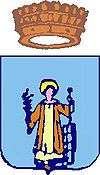San Lorenzo Nuovo
| San Lorenzo Nuovo | ||
|---|---|---|
| Comune | ||
| Comune di San Lorenzo Nuovo | ||
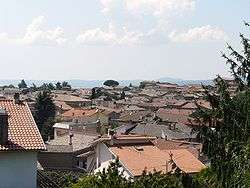 | ||
| ||
 San Lorenzo Nuovo Location of San Lorenzo Nuovo in Italy | ||
| Coordinates: 42°40′N 11°54′E / 42.667°N 11.900°E | ||
| Country | Italy | |
| Region | Lazio | |
| Province / Metropolitan city | Viterbo (VT) | |
| Government | ||
| • Mayor | Massimo Bambini | |
| Area | ||
| • Total | 27.99 km2 (10.81 sq mi) | |
| Elevation | 503 m (1,650 ft) | |
| Population (31 December 2014) | ||
| • Total | 2,109 | |
| • Density | 75/km2 (200/sq mi) | |
| Demonym(s) | Sanlorenzani | |
| Time zone | CET (UTC+1) | |
| • Summer (DST) | CEST (UTC+2) | |
| Postal code | 01020 | |
| Dialing code | 0763 | |
| Patron saint | Saint Lawrence (main patron saint), Saint Apollinare (co-patron saint) | |
| Saint day | 10 August (Saint Lawrence), 23 July (Saint Apollinare) | |
| Website | Official website | |
San Lorenzo Nuovo is a small town and comune in the province of Viterbo, in the Latium region of Italy. It is an agricultural center producing potatoes, olive oil, garlic, onions, cereals and grapes. A second source of revenue is tourism.
Geography
The town is located on the northern side of Lake Bolsena's crater rim. It dominates the lake basin on one side and the valley of the Acquapendente on the other side, at the crossing of the ancient Via Cassia (now state road 2) and the via Maremmana (state road 74). Neighbouring cities are Acquapendente, Bolsena, Castel Giorgio, Gradoli and Grotte di Castro.
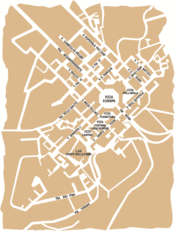
The rock known as "Sasso della graticola" is placed to mark the border with Bolsena and Castelgiorgo. The rock bears initials S L on the side facing San Lorenzo Nuovo. San Lorenzo Nuovo is famous for the harmonious symmetry and linearity of its streets, due to Francesco Navone.
History
The old village
Before 1774, the old village of San Lorenzo alle Grotte was located in the lowlands closer to Lake Bolsena than the current village. This ancient hamlet was named after the numerous surrounding caves (grotte). Originally inhabited by the Etruscans, after the Roman conquest San Lorenzo was elected municipium and prefecture. According to tradition, during the 5th-century AD invasions of the Vandals, the inhabitants had asked for protection from the heavens; on the feast of Saint Apollinare, a dense fog came down and the invaders spared the town. In 771–772, refugees came here from Tiro, a small centre placed on the hill of Civita (later "Svignata"), when the original Etruscan town of Grotte di Castro was destroyed by the Lombards under king Desiderius. It was in this area, according to Roman Martyrology, that Saint Christina of Bolsena would have been martyrized.
San Lorenzo alle Grotte had been always of strategic importance, owing to its position along the Via Cassia, in a central position for the interests of Orvieto, Viterbo and Sovana, and was contended for by local noblemen and the Church. In 1113 the area was donated to the Church by Matilda of Canossa, countess of Tuscany. The same area was sacked by the Holy Roman Emperor Henry VI in 1186. The opposition of Pope Celestine III, mediated by the bishop of Sovana, to the direct interference of the bishops of Orvieto over this area is recorded in a document dated 28 June 1183.
Towards 1265, together with neighbouring lands (Grotte di Castro, Latera, Gradoli, Bisentina island), the same area became part of the province of Val di Lago, ruled by Republic of Orvieto for a short time. In 1266, San Lorenzo took part of the Ghibellines expedition against Martana Island and other Guelphs centres but the next year it renewed its obedience to the Church. In 1294, San Lorenzo and other centres of Val di Lago, professed submission to Orvieto. It was the beginning of a series of disputes with Pope Boniface VIII. Orvieto, once excommunicated and placed under interdict, stopped any action contrary to the Church. This was not the intention of San Lorenzo, claiming actions against Orvieto. On 20 March 1298, Boniface VIII ordered to stop all hostilities and let Orvieto's army occupy the castle of San Lorenzo. Although returned to Orvieto's jurisdiction, the centres of Val di Lago resisted paying their tribute for three years. In 1315, San Lorenzo was involved in the fights between Orvieto and the papal legate Bernard of Cluny, being defeated at Montefiascone by Guittuccio of Bisenzio. In 1318, San Lorenzo supported with 25 infantries Orvieto against Ugolinuccio de' Neri of Montemarano. In 1354, in the presence of Gil Alvarez De Albornoz, all villages of Val di Lago confirmed their submission to Orvieto. In 1359, the Republic of Orvieto was abolished and Cardinal Albornoz brought San Lorenzo again under the jurisdiction of the papacy.
In 1527, the landsknechts, on their way to Rome, burnt San Lorenzo, Bolsena and Montefiascone. An agreement was achieved between San Lorenzo and Grotte di Castro about rights and duties of land owners residing in their respective territories.
In the early 1630s, a painting of a view of San Lorenzo was produced by the visiting Flemish painter Bartholomeus Breenbergh. Known as a pastoral landscape with a citadel, an engraving by the Swiss engravers Balthasar Anton Dunker and Robert Daudet is the inverse image of Breenbergh painting.[1]
The new village
The new town was built in 1774. The area of San Lorenzo alle Grotte was rather unhealthy, as acknowledged by the marble frame kept in the central square of the new town. People were affected by malaria and other epidemics, and trade had ceased. Cardinal Giovanni Angelo Braschi, future Pope Pius VI, at the time when he was apostolic treasurer, after the many failures in trying to decontaminate the area, induced Pope Clement XIV to take the decision to move all homes from the hollow, unhealthy areas by the lake to a higher and more liveable place, in order to be safe from the frequent floods which hit the plains. An area was identified on a wide upland in the vicinity of the old village (in a location named Gabelletta) and next brought on mandate of the Reverend Apostolic Chamber. Initially, with a signed document dated 3 June 1772, Pope Clement XIV commissioned the work of reconstruction to architect Alessandro Dori and then to architect Francesco Navone, who designed a sort of ideal city according to urban planning canons of his time.
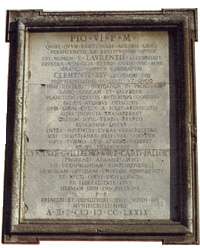
Once Pope, Pius VI made efforts to have the works completed and entrusted to Cardinal Guglielmo Pallotta, vice apostolic treasurer, the carrying out of the works. The original route of Via Cassia was modified, leaving the old village completely isolated. Water was brought and the village of San Lorenzo Nuovo was founded. The parish, the central square, the Governor's Palace (then Palazzo Comunale), and a few buildings housing about 300 people were in place in 1777. As a sign of gratitude, two years later the citizens created and put on view a marble frame in memory of the saviour and founder of the new town.
On 22–23 February 1798 on his way to Florence as prisoner of the French, Pius VI had the opportunity to stop by San Lorenzo Nuovo for an address to the population. On 10 August 1929, a memorial stone was placed on the house of family Pacetti, to commemorate the visit of the prisoner pope. Bands of Giuseppe Garibaldi's followers crossed into the Papal States in September 1867 and came into fights with the Papal Zouaves. On the territory of San Lorenzo Nuovo, Monte Landro was the theatre of the defeat of Garibaldi's men.
In May–June 1944, in the course of World War II, San Lorenzo Nuovo suffered aerial bombardment by Allied forces, with numerous casualties and substantial damages.
In April–May 2006, to celebrate 500 years in the line of duty a group of veteran Swiss Guards marched from Switzerland, stopping in San Lorenzo Nuovo on their way to Rome.
Main sights
Piazza Europa
Road Cassia, over the tract between Acquapendente and Bolsena, at km 124, crosses through an octagonal square, just in front of the parish church of San Lorenzo Martire.This is the centre of San Lorenzo Nuovo, Piazza Europa, a wide square regarded as an interesting example of 18th century urban planning.
The artist Francesco Navone adopted an innovative technique meant to create the plan of the new town in the style of Copenhagen Amalienborg square. A sign of the originality of Navone's project was also the uniformity of the buildings. Little differences can be noticed between the nobles' and the common people's houses, the only exception being San Lorenzo Martire, which stands out of the other buildings for its considerable height.
Collegiate church of San Lorenzo Martire

The 34-metre (112 ft) height parish church of San Lorenzo Martire dominates Piazza Europa. Surrounded by numerous ex-voto, a crucifix is kept in its fine chapel. It is a 12th-century Byzantine statue made of polychrome wood. On 12 October 1778 it was escorted in a solemn procession from the old village to the new church. The crucifix has been venerated ever since.
Two mannerist canvases of Jacopo Zucchi, representing the Ascension and Resurrection are housed in the church. Originally constructed by Cardinal Aragona for his private chapel in Vatican, they were donated to the town by Pope Pius VI in 1777. Behind the altar, a painting by the Filippo Bracci depicts the Martyrdom of Saint Lawrence and Saint Apollinare with the Virgin Mary and child (1779). Remains of Saint Apollinare, the town's co-patron, together with the ones of Saint Lawrence and Saint Stephen, were supposedly found in ancient altar and re-entombed in the sepulcher donated by Acaste Bresciani to the new altar in 1938. The Triumph of Saint Lawrence in the apse of the church is a tempera paint composition of Testa (1940).
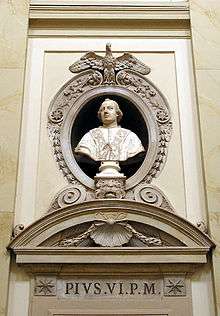
The pulpit comes from the ex-church of Saint Augustin in Orvieto. A marble torso, attributed to Antonio Canova and placed besides the main altar, represents Pope Pius VI. as well as the square, the church was designed by architect Francesco Navone. The church façade reproduces a simple geometry, as well as the internal part, characterized by longitudinal geometry including one nave and lateral chapels. On top of the church main door the coat of arms of Pope Pius VI, made in the laboratories of Antonio Canova, is on view.
Navone also created the building system adjacent to the church, and convent of the Capuchin Fathers situated to the west side of the Via Cassia. It was designed in such a way that the location of the parish church and that of the convent should result at the very ends of a huge axis having the shape of a Latin cross.
Church of Capuchin Fathers

The church of Capuchin Fathers, is a single nave building with three lateral chapels on each side. Corso Umberto I, ideally equivalent to the Royal street of Copenhagen, is a straight street connecting Piazza Europa to the church of Capuchin Fathers. The church was completed in 1784, and dedicated to a Capuchin friar, Saint Seraphim of Montegranaro. The interiors were finely decorated by the Sicilian Capuchin friar, painter and littérateur, Fidelis of San Biagio (1717–1801). He painted: Immaculate Conception with Saint Seraphim of Montegranaro, Saint Francis receiving stigmata, martyrdom of Saint Fidelis of Sigmaringen, ecstasy of Saint Lawrence of Brindisi, Sacred Family with Saint Felix of Cantalice, martyrdom of Saint Joseph of Leonessa. The painting representing the blessed Bernard of Corleone was lost during World War II. At present, the church is dedicated to the Assumption of Mary. Built in the early 18th century, it was part of a convent of the Capuchin Fathers until 1810, when all religious orders were suppressed by Napoleon I.
In 1997, the church housed a photo exhibition depicting the history of the Shroud of Turin.
Church of Torano
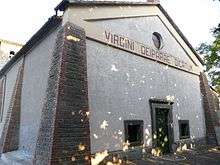
The neighbouring areas feature the noticeable church of Torano, probably built after an Etruscan temple (Tyranus ager). The Virgin Mary "Turan" was honored here, named after the Etruscan goddess Turan (ruines of an Etruscan worship area were found close to the church). The church houses a fresco of the Virgin Mary on the throne, with the blessing Christ Child naked on his mother's knees and a flower to the right, dating back to the 15th century. The Holy Trinity (top part) and the saints Agata and Apolonnia are also painted in the same fresco. Based on the memories of his Lordship Acaste Bresciani, the church is probably the remainder of an ancient Benedictine monastery. Half-size small, it was expanded in 1875 thanks to Reverend Eugenio Licca and donations and voluntary works by the population.
Church of San Giovanni in Val di Lago

Near to the lake, between San Lorenzo Nuovo and Bolsena, are ruins of the church of San Giovanni in Val di Lago (destroyed by the earthquake of 30 May 1563). The area, also known as "Civita di Grotte di Castro", was used until 1799 to host the yearly celebrations of Saint John the Baptist on 24 June. The octagonal church, dedicated to Saint John the Baptist, was rebuilt in 1563 by the architect Pietro Tartarino, an apprentice of Alberto da Sangallo. Stuccos by Ferrando Fancello are no longer present here.
Park of the Grottoes
It is known with this name (Parco delle Grotte[2]) a vast area covering 1,310 hectares (3,200 acres) over most of the ancient settlement of San Lorenzo alle Grotte (and a small area of the commune of Grotte di Castro). The area extends northwards from the Lake Bolsena borders up towards the Vulsini volcanic caldera margin. The minimum elevation is at 300 metres (980 ft) above sea level (lake border) and the maximum at 584 metres (1,916 ft) on (Monte Landro), with a difference in level of 284 metres (932 ft). The zone is characterized by the presence of several grottoes and cavities excavated in the tuff. The biggest one is of regular shape, with a length of about 30 metres (98 ft). Two visit centres are meant to be located in the park: centre San Lazzaro along the Via Cassia at km 122, and centro Paese Vecchio near the ancient village. The Park is part of the Territorial Museum of Lake Bolsena, supported by Lazio Region and Viterbo Province.
The Brigands' path
During the 19th century the area across Latium, Umbria and Tuscany marked the southern border of the Grand Duchy of Tuscany and, since 1861 the Kingdom of Italy and the States of the Church. The area included woodlands such as Selva del Lamone and Monti di Castro, with isolated caves and small rivers out of the main roads. Several brigands used to live here. One of the latest brigands of northern Latium, in action at the end of the 19th century when the area became part of the Kingdom of Italy, was Fortunato Ansuini. He was as cruel as anybody else. The most influential brigand of the zone was Domenico Tiburzi, who was called Domenichino, and was known as the King of Lamone, or the Robin Hood of Maremma. He always refused to come into alliance with Ansuini because he considered him no more than a common outlaw. Born at Norcia in 1844 from a family of farmers, Ansuini was forced by parents to work as a stonemason. He killed a man in a tavern and was sentenced to 11 years in prison in Rome. In May 1866, together with three jail-mates, he escaped through a drain. The fugitives left Rome and chose Maremma as a secure place for their furtiveness. Here, their new life had a start, made of robberies and racketeering to get weapons, bullets, and money. The gendarmes were on their traces and forced them to continuously move from one place to another, without capturing them for a long time. The soldiers could identify them with the help of a spy, and caught them while banqueting inside a cave. The outlaws surrendered soon.
In April 1890, Ansuini was locked up in the fort Filippo II to the Monte Argentario. Again, he arranged for an escape together with other captives. Breaking off the chains that were keeping them blocked, they went out through the window with the help of bed sheets. The next night the brigands stormed a shepherd house near Capalbio, tied up the shepherds and raided food, money, weapons, and bullets. The bloodthirsty brigand Damiano Menichetti was part of the group. He came soon into close alliance with Ansuini, whilst the others left them.
Several anecdotes are known about Ansuini. He liked to mock the gendarmes, leaving signed fliers in the same restaurants where he used to eat. Once he went elegantly dressed to Bassano in Teverina and entered the barracks of carabinieri in the name of a trade man on travel from Milan. On his request, he had an escort of two gendarmes, for personal protection during his journey. At the end he asked the two men to deliver a flyer to their commander. It came about that the commander expressed all his anger when he read the paper with the signature of Ansuini. The phenomenon of brigandage was close to being extinguished. Ansuini disappeared after a fight with carabinieri. Menichetti was captured after killing the brigadier Sebastiano Preta, and died in prison.
The Brigands' Path is an historical hiking trail that follows in the footsteps of some of Italy's infamous notorious figures. It is a 120-kilometre (75 mi) trail that links the Tyrrhenian Sea (area of Vulci) to the Apennine mountains of central Italy. A trail is marked in the area across Onano, Grotte di Castro, Gradoli and San Lorenzo Nuovo where the adventures of Ansuini and other brigands set their stage.
Events
Sagra degli Gnocchi
Firstly introduced in the 1970s as a celebration of potato as the main local agricultural produce, the Gnocchi's Festival (in Italian, Sagra degli Gnocchi) is a typical mid-August event in San Lorenzo Nuovo. The town's main square is transformed into a large, open-air restaurant where the visitors can taste potato gnocchi, and other typical local recipes such as pigskin beans, tripe, and roasted sausages. A special atmosphere is created by liscio and rock orchestras in the context of cultural, sporting and religious (patron saint day and Assumption of Mary) events.
Sanlorenziadi
The term 'sanlorenziadi' (literally Olympic games of San Lorenzo Nuovo) refers to non-professional sporting and game competitions opposing the "yiellows" (from the colour of the contrade 'Pergolino', located eastern side from Via Cassia) to the "blues" (from the colour of the contrade 'Convento', located western side from Via Cassia). The town's central square is the main site of public games. Discontinuously taking place since the 1980s (1984, 1988, 1989, 1990, 1994, 1995), sanlorenziadi is a typical summer event. Originated from the long lasting tradition of football match Pergolino-Convento (since 2000 memorial "Antonio Cimpella"), it consists of an array of sporting competitions combined with popular games. A magnificent inaugural happening precedes the games, which attracts visitors and spectators. The summer 2007 games (21 July – 5 August), won by Pergolino, were organized by the local cultural association 'Scacciapensieri'. Sanlorenziadi edition 2008 (18 July – 3 August), jointly organized by 'Scacciapensieri' and 'Associazione Culturale Giovani Laurentini', was also won by Pergolino. As well, Pergolino won edition 2009, organized by 'Associazione Culturale Giovani Laurentini', and edition 2010. The 2011 edition was not played and was the occasion of an 'old glories' football match (won by Pergolino). Convento won the 2012 edition.
17 January, Saint Anthony the Abbot
Yearly celebration of Sant'Anthony the Abbot is a typical farming feast, characterized by blessing of the animals, distribution of faba bean soup, show of chariots and animals, and snack with anchovies, Saint Anthony "biscuit" and wine.
24 June, Saint John Baptist
The fair of Saint John is a popular event whose origin dates back to the Middle Age. This yearly fair goes on the entire day of 24 June all around the central square. Until the 19th century, the same fair had been having place near lake Bolsena, in the area of the church of San Giovanni in Val di Lago.
10–11 August, Saint Lawrence Martyr
San Lorenzo Nuovo was named after the patron Saint Lawrence, martyr. Every year, on 10 August a solemn procession marks the highlight of the occasion according to a longstanding tradition. Moving from the parochial church, the procession carries the statue of the Saint through the village streets. The next day, a traditional fair takes place.
15 August, Assumption of the Virgin Mary
The Assumption of Mary is celebrated every year by a procession in which the statue of Mary is carried from the church of Capuchin Fathers in the neighbour streets.
8 September, Virgin Mary "Turan"
"Madonna di Torano" is celebrated every year according to a secular tradition. On 8 September, the so-called "Ladies of Turan" protagonize the event. They are three 16-year-old girls selected as godmothers of the feast. In the morning, they use to take off until they reach the rural church of Turan (about 1.5 km away from the centre). In the afternoon, convivial events take place in the area of the church.
14 September, Exaltation of the Holy Cross
According to an ancient popular tradition, the wooden crucifix dating back to the 12th century and housed in the parochial church is object of deep veneration. Every year a religious procession is celebrated on 14 September (feast of the Very Holy Cross), but it is only every 15 years (probably since 1787) that a solemn procession takes place on the same day carrying the cross through the village streets finely decked for the occasion. This procession, celebrated in memory of the transfer of the statue from the old village to the parochial church of the new municipium (12 October 1778), is joined by the people, the representatives of the local authorities, the local band, the SS. Crocifisso Brotherhood, the flag-wavers with a parade of the historical cortege. An array of events, collectively known as "Festone" (Big Feast), span over the summer months with traditional feasts and other forms of merriment. The Festone was lastly celebrated in 2012. In 2000, on the occasion of the Great Jubilee, both civil and religious authorities took the decision for an exceptional procession, out of the habitual festivities.
Famous citizens
- Lorenzo Cozza, friar Minor, cardinal and theologian
- Acaste Bresciani, Roman Catholic priest and author
See also
- Fanum Voltumnae
- Gianni Bellocchi
- Leonardo Ambrosini {30 June 1974 – 23 February 2008} (Italian)
References
- ↑ "Bartolomeus Breenbergh* (1598–1657)". Christie's. Retrieved 8 August 2008.
- ↑ http://www.bibliotecaviterbo.it/Rivista/2003_3-4/Bevagna.pdf
- Amministrazione Comunale, Associazione Pro Loco, Festone 1997, XXa Sagra degli Gnocchi, 1997.
- Comunità Montana Alta Tuscia Laziale, Il sentiero dei briganti, guida 2006.
- Munari Mario, San Lorenzo Nuovo – Storia della fondazione 1737–1774, Grotte di Castro, 1975.
- Richter Ulf – Monte Luana, Il Fanum Voltumnae: misterioso "cuore" dell'antica Etruria. Antikitera.net.
- Roethlisberger Marcel, Bartholomaeus Breenbergh (1600–1659). The Paintings, Berlin, 1981.
- Scuola Media Statale San Lorenzo Nuovo, San Lorenzo ricorda. 1945–1995, 50 anni dalla fine della guerra, 1995.
External links
- Official website (Italian)
- Comuni Italiani website (Italian)
- Tourism page (Italian)
- Lake Bolsena
- Mountain Community "Alta Tuscia Laziale" (Italian)
- Tusciaweb (Italian)
- International Association Via Francigena
- Associazione Culturale Giovani Laurentini (Italian)
- Facebook | San Lorenzo Nuovo (Italian)
- Facebook | San Lorenzo Nuovo Youth Committee for Marco Bottarini (Italian)
